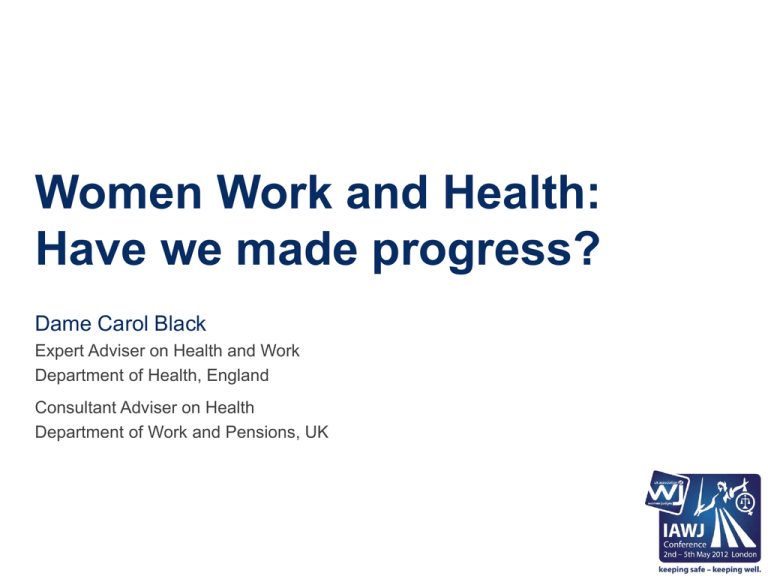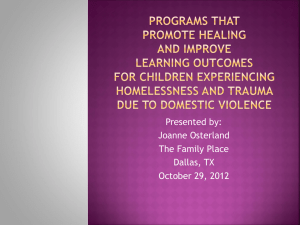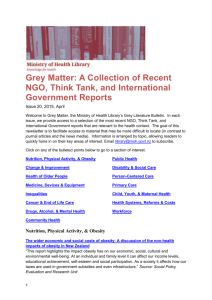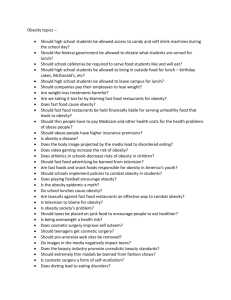
Women Work and Health:
Have we made progress?
Dame Carol Black
Expert Adviser on Health and Work
Department of Health, England
Consultant Adviser on Health
Department of Work and Pensions, UK
Social Determinants of Health
•
•
•
•
•
•
•
•
•
•
The social gradient
Stress
Early life
Social exclusion
Work/Unemployment
Social support
Addiction
Food
Transport
Education
Work: its value
• Work is a social determinant of health
• Work is generally good for health – the two are
inextricably linked
• Enabling people to be in productive work is a
health issue
• Work provides income: material well-being and
participation in today’s society
• Work meets important psychosocial needs in
societies where employment is the norm
• Employment and socio-economic status are the
main drivers of social gradients in health
• Work needs to be ‘good work’
Galen (129-200)
“Employment is
nature’s physician
and is essential to
human happiness.”
A more feminised workforce
UK Workforce participation rates 1971 to 2008
Is this work
‘good work?’
From R.Donkin, The Future of Work, 2010
A more feminised workforce
USA Workforce participation rates 1948 to 2005
The needs of a worker, male or female
• To be healthy enough to work
• Safe healthy workplaces - physically safe
- emotionally healthy
• good work:
• job security
• work varied and interesting
• workers have some autonomy, control and
task discretion
• fair rewards (not just financial) for effort
• supportive social relationships
• worker engagement.
The various countries of the world are at different
stages in providing the above.
The nature of work is changing in many countries.
Women and work in the
European Union
Women:
• More likely than men to be unemployed or in low-paid jobs
• Still dominate employment in sectors such as health care and social
services, education, public administration and retailing
• Severely under-represented in economic decision-making :
•
•
Only 11% of board members in Europe’s biggest listed companies are female
Only 3% of such companies have a woman in charge
(Norway is the exception – the result of a quota by law)
Men:
• Work as technicians, engineers, finance professionals and managers
• Remain about twice as likely as women to be managers,
and three times as likely to be senior managers
Dehumanisation of work
Anna Sam: ‘The Tribulations of a Check-out Girl’
Sam often heard mothers admonish their
children as they approached her till:
“If you don’t work hard at school you will
end up like that lady at the counter.”
You do not often see men working on
supermarket checkouts except for
students in part-time jobs.
Work can make you sick.
It took a book for businesses to wake up and realise that here
was not a human machine but a living, breathing and thinking
human being.
Example taken from R.Donkin, The Future of Work, 2010
Dehumanisation of work
Polly Toynbee: ‘Hard Work’
In the book she explored the disadvantages for those in
low-paid work by undertaking, aged 55 at the time, a series of
poorly-paid, poorly-regarded jobs.
Often she worked as a casual agency employee
at or near the minimum wage.
Not only was her experience an indictment of policies that have
broadened the gap between rich and poor in the UK...
...it also highlighted the working realities for thousands of women.
Some 80% of the ten lowest-paid occupations are
undertaken by women.
Low-income US women and
employment
Findings from a US study of employment experiences and
opportunities of low-income women in racially-segregated communities:
• 52% are currently working in low-wage service-sector jobs, and prefer
jobs in healthcare and childcare
• Women typically have held several jobs for relatively short periods,
with work histories punctuated by periods of non-work and welfare
receipt
• They often stop working because of layoffs, childcare and
transportation problems, pregnancy, illness or disability
• Most are single mothers, and they evaluate the costs and benefits of
working in terms of their overall family responsibilities.
From Scottish Government and Health Action Partnership International, 2012
Long-term unemployment
Can lead to:
• Poorer physical health
• Poorer mental health
• Greater usage of medical services
• Poorer social integration
• Loss of worth and self-confidence
• Less monetary resources
• Trans-generational effects
Re-employment can reverse
these changes
What prevents us from working
The two most common reasons given are:
• Common mental health problems
• Musculo-skeletal problems
•
•
•
•
•
High prevalence across population
Little or no objective disease or impairment
Most episodes settle rapidly, though symptoms often persist or recur
Essentially whole people, with what should be manageable health conditions
Psychosocial factors important – especially in chronic disability.
Plus other factors:
• Chronic diseases – mental and physical
• Obesity-related diseases
• Domestic violence, addiction
• Lack of education and/or skills
• Deprivation, poverty, lack of jobs.
Relative importance of these factors will vary
with gender, type of work, and country.
Women: poverty, mental ill-health
and work in the EU
• Women form the majority of the EU’s economically inactive, more
likely than men to be poor. Some 35% of single parents, mainly
women, live in poverty.
• Adults in the poorest fifth of the income distribution are more at
risk of developing a mental illness than those on average income –
and they are less likely to be employed.
• Therefore, poorer women have worse levels of mental health and
coping capacity to deal with life circumstances.
• One in six adults in the UK suffer from a common mental health
disorder such as depression, anxiety, phobias and panic attacks.
• About 12.8 million working days (40% of total in UK) are lost due to
stress, anxiety and depression each year.
From Scottish Government and Health Action Partnership International, 2012
Domestic Violence
Globally, at least one in three women is beaten, coerced into sex or
otherwise abused by an intimate partner, in the course of her lifetime.
Some of the reasons DV still persists:
• Women’s economic dependence on men
• Expectations of roles within relationships
• Limited access to employment in formal and informal sectors
• Limited access to education and training for women
• Lesser legal status of women in some countries by written law and/or
practice (though with some ongoing improvement).
•
•
•
Domestic violence has damaging consequences to health and to
the economy.
In India, each incident of domestic violence translates on
average into women losing seven working days
[United Nations report].
This is a difficult topic for employers, but there are some
exemplary companies
Co-ordinated community response
in the UK
• Government, law enforcement, courts, the voluntary sector and
private sector have all worked together in partnership. Legislative
framework and National Delivery Plans helped to set out the aims.
• Some of the outcomes include:
• 64% fall in the number of domestic violence incidents between 1995
and 2007/8.
• Successful prosecution rate increased from 47% to 64% in 2007/08,
and then 72.5% in 2009, and in some areas up to 90%.
• Significant decrease in fatalities reported by the Metropolitan Police,
from 49 deaths a year in 2003 related to domestic violence to 5 in
2010.
• Greater coordination of services has meant better value for money,
and more effective response.
EDV Global Foundation
- Catalyst for change
The Eliminate Domestic Violence global foundation is a non-profit
organisation with the aim to eliminate domestic violence on a
global scale.
• Working in partnership with countries, international and national
agencies, and based on credible international standards, the
Global Foundation sets out to provide the expertise needed to
achieve this.
• The EDV Foundation can help by:
•
•
•
•
Identifying if there is baseline data available initially.
Providing suggested data sets.
Providing training and advice.
Providing on-going support.
Founder: Baroness Scotland QC
www.gfedv.org
International obesity statistics
57
75.7
48
Estimated Overweight &
Obesity(BMI ≥ 25 kg/m²)
Prevalence, Females,
Aged 15+, 2010
66.5 36.9 57.1 74.2 47.2 63.8 76.7
In an increasingly competitive global economy, only the
healthiest businesses will prosper. Companies that invest to
support employees’ health will be fitter to survive.
USA
Sweden
67.2 73.9
UK
New
Zealand
France
Germany
Australia
Estimated Overweight &
Obesity(BMI ≥ 25 kg/m²)
Prevalence, Males,
Aged 15+, 2010
67.8 80.5
Obesity and consequent disease in
the UK
It is likely that by 2025 40% of adults
will be obese, and the number of
people living and working with
chronic conditions will rise steadily,
affecting morale, competitiveness,
and profitability.
Predicted rates per 100,000
2006
2030
2050
Arthritis
603
649
695
Breast cancer
792
827
823
Colorectal cancer
275
349
375
Diabetes
2869
4908
7072
Coronary heart disease
1944
2471
3139
Hypertension
5510
6851
7877
Stroke
792
887
1050
Rheumatoid Arthritis and work
•
•
•
•
RA is more common in women
Half UK adults with RA are of working age
75% are diagnosed when of working age
One in three people with RA will have stopped
working within 2 years.
• Earlier diagnosis and appropriate treatment
mean better retention in work.
• Increasing from 10% to 20% the number of
people treated within 3 months of symptoms
would increase NHS costs in England by £11
million over 5 years
• BUT could result in £31 million gain for the
economy due to reduced sick leave and workrelated disability.
National Audit Office
Report 2009
Public Accounts Select
Committee 2010
Rheumatoid Arthritis and work
• Report identified lack of coherence in links between the
National Health Service and organisations commissioned by
the Department of Work and Pensions to get people back
into work.
• Only 56% of hospitals were aware of DWP schemes, and
33% of these did not give RA patients appropriate information.
• Only 12% of family doctors gave information about continuing
in employment to those newly diagnosed with RA.
• Only 20% of patients with RA considered that they received
sufficient information about employment issues.
National Audit Office Report 2009
Cancer and work
Cancer is becoming a long term condition
• 109,000 working-age people are diagnosed with
cancer in the UK each year
• 775,000 people of working age in the UK have
had a cancer diagnosis
• Long term cancer survivors are 1.4 times more
likely to be unemployed yet…
• … research shows that cancer patients want
to work
• One in four long term cancer survivors say their cancer is
preventing them working in their preferred occupation
• The average fall in household income for a family of working age
with cancer is 50%...
• ... and 17% lose their home
MacMillan Cancer Support
National Cancer Survivorship Initiative
Emerging findings – September 2010
•
Joint project: Macmillan Cancer Support, Department of Health and
NHSI testing ways of providing Vocational Rehabilitation for people with
cancer.
•
Seven pilot sites across England to test a model of VR which includes
providing information, face to face support, and access to learning
programmes and a case manager.
Emerging themes:
• Patients want attention to work issues early, and revisits during
treatment and follow-up
• Health professionals inadvertently give mixed messages about work
• Line managers are key but may not have the knowledge and skill to
manage a patient’s return to work
• Patients need more information about rights and
responsibilities with regard to employment
• Specialist vocational rehabilitation services can proactively
anticipate patient problems
Cancer and shift work
•
Extensive animal evidence suggests that disruption of circadian
rhythms can increase the risk of cancer, by a variety of mechanisms.
•
Epidemiological studies provide supporting, but not conclusive,
evidence of increased risk of breast cancer in shift workers
•
HSE has commissioned the Cancer Epidemiology Unit in Oxford
University to investigate, using two large cohort studies (The Million
Women Study and EPIUC-Oxford), focussing on shift-working in
relation to cancer and other chronic conditions
•
Cross-sectional studies show that shift-working women are in general
less affluent, with different reproductive histories and increased
prevalence of obesity and smoking – thus probably with increased risk
of cancer etc.
•
Analysis of these complex risk factors, once sufficient data are
collected, will help this investigation of the relationship between
night work and chronic disease
Changes and their consequences
• The contraceptive revolution that from around 1965 gave women
reliable independent control of their fertility
• The changing nature of work, e.g. expansion of white-collar jobs,
home working, job sharing
• Expansion of work for secondary earners who may want to retain
other interests beyond paid work
• Equal opportunities and sex discrimination legislation
• Increase in significance of attitudes, values, personal preferences in
modern liberal societies
• The new negatives: lifestyle, obesity, alcohol,
lack of physical exercise, chronic disease
Church House Conference Centre
London












